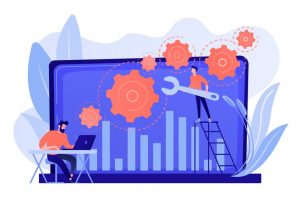 Scaling up a business brings exciting growth opportunities, such as reaching new markets, increasing revenue, and enhancing brand recognition. However, this phase also introduces significant operational challenges that must be addressed for sustainable expansion. This article delves into common hurdles businesses encounter during scaling, including resource allocation, infrastructure upgrades, process optimization, talent management, supply chain complexities, customer service demands, and regulatory compliance. It also offers practical solutions, such as strategic planning, investment in technology, process standardization, and enhanced customer support, to help businesses overcome these challenges and achieve long-term success.
Scaling up a business brings exciting growth opportunities, such as reaching new markets, increasing revenue, and enhancing brand recognition. However, this phase also introduces significant operational challenges that must be addressed for sustainable expansion. This article delves into common hurdles businesses encounter during scaling, including resource allocation, infrastructure upgrades, process optimization, talent management, supply chain complexities, customer service demands, and regulatory compliance. It also offers practical solutions, such as strategic planning, investment in technology, process standardization, and enhanced customer support, to help businesses overcome these challenges and achieve long-term success.
Identifying Operational Hurdles in Scaling a Business
Scaling a business is a multifaceted process that offers immense opportunities for growth. However, this growth phase introduces numerous operational challenges that can threaten the sustainability of expansion if not properly managed. Here, we identify and delve into the key operational hurdles businesses often face during scaling and provide strategies to overcome them.
A. Resource Allocation
 Efficient resource allocation is paramount to support growth while avoiding overextension of the company’s capabilities. Resources encompass manpower, finances, materials, and time. During the scaling process, businesses must ensure that these resources are distributed effectively to maximize productivity and support expansion initiatives.
Efficient resource allocation is paramount to support growth while avoiding overextension of the company’s capabilities. Resources encompass manpower, finances, materials, and time. During the scaling process, businesses must ensure that these resources are distributed effectively to maximize productivity and support expansion initiatives.
- Manpower: Businesses need to hire additional employees or optimize the current workforce to handle increased workloads. This may involve identifying skill gaps and conducting targeted hiring.
- Finances: Proper budgeting and financial management are crucial to fund expansion activities. This includes securing necessary capital, managing cash flow, and controlling costs.
- Materials: Ensuring a steady supply of raw materials and inventory to meet increased production demands without causing delays or shortages.
B. Infrastructure
 As businesses scale, upgrading or expanding physical and technological infrastructure becomes necessary to meet increased demand and maintain productivity.
As businesses scale, upgrading or expanding physical and technological infrastructure becomes necessary to meet increased demand and maintain productivity.
- Physical Infrastructure: This might involve expanding office or manufacturing space, upgrading equipment, or enhancing distribution facilities. Businesses must plan for these changes to avoid bottlenecks that can hamper growth.
- Technological Infrastructure: Investing in scalable technology solutions, such as cloud computing, robust ERP systems, and advanced analytics, can enhance operational efficiency and support larger volumes of work.
C. Process Optimization
 Streamlining business processes is essential to handle higher volumes of work without compromising quality or efficiency.
Streamlining business processes is essential to handle higher volumes of work without compromising quality or efficiency.
- Workflow Automation: Implementing automation tools can reduce manual tasks, minimize errors, and improve productivity. This includes automating repetitive tasks in areas such as data entry, invoicing, and customer service.
- Lean Methodologies: Adopting lean principles can help identify and eliminate waste in processes, thereby improving efficiency and reducing costs. Continuous process improvement should be a priority to adapt to changing demands.
D. Talent Management
 Attracting, retaining, and training employees who can adapt to and support the growing needs of the business is a significant challenge during scaling.
Attracting, retaining, and training employees who can adapt to and support the growing needs of the business is a significant challenge during scaling.
- Recruitment: Developing a strong recruitment strategy to attract top talent is crucial. This may include offering competitive salaries, benefits, and career advancement opportunities.
- Retention: Retaining skilled employees through effective engagement, recognition programs, and a positive work environment is vital to maintain stability.
- Training and Development: Providing continuous training and professional development opportunities helps employees adapt to new roles and responsibilities, fostering a culture of growth and learning.
E. Supply Chain Management
 Managing a more complex supply chain is often required as businesses scale, involving new suppliers, larger inventories, and expanded logistics networks.
Managing a more complex supply chain is often required as businesses scale, involving new suppliers, larger inventories, and expanded logistics networks.
- Supplier Relationships: Establishing strong relationships with reliable suppliers ensures a consistent supply of materials and helps negotiate better terms.
- Inventory Management: Implementing advanced inventory management systems can help maintain optimal stock levels, reduce carrying costs, and avoid stockouts.
- Logistics: Enhancing logistics capabilities to handle increased distribution demands is critical. This includes optimizing transportation routes, warehousing, and delivery schedules.
F. Customer Service
 Maintaining high levels of customer satisfaction as the business grows requires scaling customer service teams and support systems.
Maintaining high levels of customer satisfaction as the business grows requires scaling customer service teams and support systems.
- Customer Support Teams: Expanding customer support teams to handle increased inquiries and provide timely assistance is essential. This may involve hiring additional staff, training existing employees, and implementing support technologies.
- CRM Systems: Utilizing Customer Relationship Management (CRM) systems helps manage customer interactions, track service issues, and improve overall customer experience.
G. Regulatory Compliance
 Navigating new regulatory environments, especially if the expansion involves entering new geographical markets or industries, presents another significant challenge.
Navigating new regulatory environments, especially if the expansion involves entering new geographical markets or industries, presents another significant challenge.
- Compliance Management: Establishing a robust compliance management system ensures that the business adheres to all relevant laws and regulations. This includes staying updated with regulatory changes and implementing necessary policies and procedures.
- Risk Management: Conducting regular risk assessments to identify potential compliance issues and developing mitigation strategies helps avoid legal pitfalls and ensures smooth operations.
Solutions to Overcome Operational Hurdles in Scaling a Business
Scaling a business requires addressing various operational challenges to ensure sustainable growth. Implementing effective solutions in key areas can help businesses navigate these hurdles successfully. Here, we discuss seven critical solutions: planning, investment in technology, process standardization, human resources strategy, supply chain optimization, enhanced customer support, and compliance management.
A. Strategic Planning
 Developing a comprehensive growth strategy is the foundation for successful scaling. Strategic planning involves creating detailed plans for resource allocation, infrastructure upgrades, and process improvements.
Developing a comprehensive growth strategy is the foundation for successful scaling. Strategic planning involves creating detailed plans for resource allocation, infrastructure upgrades, and process improvements.
- Resource Allocation: Identify and allocate resources such as finances, manpower, and materials efficiently. This ensures that all aspects of the business are well-supported during growth phases. Regularly review and adjust resource distribution to adapt to changing demands and priorities.
- Infrastructure Upgrades: Plan for necessary upgrades to physical and technological infrastructure. This includes expanding office space, upgrading manufacturing facilities, and enhancing IT systems to accommodate increased workloads and maintain productivity.
- Process Improvements: Continuously analyze and improve business processes to increase efficiency and reduce bottlenecks. Implementing lean methodologies and adopting best practices can streamline operations and support growth.
B. Investment in Technology
 Investing in scalable technologies is crucial for enhancing operational efficiency and supporting growth. Technology can automate tasks, provide valuable insights, and facilitate better decision-making.
Investing in scalable technologies is crucial for enhancing operational efficiency and supporting growth. Technology can automate tasks, provide valuable insights, and facilitate better decision-making.
- Cloud Computing: Adopt cloud-based solutions for data storage, software applications, and collaboration tools. Cloud computing offers flexibility, scalability, and cost savings, enabling businesses to handle increased demands seamlessly.
- Automation Tools: Implement automation tools to streamline repetitive tasks, reduce errors, and improve efficiency. This includes automation in areas such as data entry, invoicing, inventory management, and customer service.
- Advanced Analytics: Utilize advanced analytics to gain insights into business performance, customer behavior, and market trends. Data-driven decision-making can help identify opportunities for growth and areas that need improvement.
C. Process Standardization
 Standardizing and documenting business processes ensures consistency and efficiency as the company scales. Well-defined processes enable smoother operations and better coordination among teams.
Standardizing and documenting business processes ensures consistency and efficiency as the company scales. Well-defined processes enable smoother operations and better coordination among teams.
- Documentation: Create detailed documentation for all key processes, including step-by-step instructions, roles, and responsibilities. This helps maintain consistency and provides a reference for training new employees.
- Standard Operating Procedures (SOPs): Develop SOPs for critical operations to ensure that tasks are performed correctly and efficiently. Regularly review and update SOPs to reflect changes and improvements in processes.
- Process Audits: Conduct regular process audits to identify inefficiencies and areas for improvement. Use the audit findings to refine processes and enhance overall operational performance.
D. Human Resources Strategy
 A robust human resources strategy is essential for attracting, retaining, and developing talent. Investing in HR policies and training programs keeps the workforce skilled and motivated, supporting the growing needs of the business.
A robust human resources strategy is essential for attracting, retaining, and developing talent. Investing in HR policies and training programs keeps the workforce skilled and motivated, supporting the growing needs of the business.
- Recruitment: Develop a strong recruitment strategy to attract top talent. This includes creating compelling job descriptions, leveraging various recruitment channels, and offering competitive compensation and benefits.
- Onboarding: Implement a comprehensive onboarding program to help new hires integrate smoothly into the organization. Effective onboarding enhances employee engagement and reduces turnover.
- Training and Development: Invest in continuous training and professional development programs. This ensures that employees stay updated with the latest skills and knowledge, fostering a culture of growth and innovation.
E. Supply Chain Optimization
 Optimizing the supply chain is vital for improving coordination, reducing costs, and increasing responsiveness to market demands. Advanced supply chain management tools can enhance efficiency and support growth.
Optimizing the supply chain is vital for improving coordination, reducing costs, and increasing responsiveness to market demands. Advanced supply chain management tools can enhance efficiency and support growth.
- Supplier Relationships: Build strong relationships with reliable suppliers to ensure a consistent supply of materials. Collaborate with suppliers to negotiate better terms and improve supply chain resilience.
- Inventory Management: Implement advanced inventory management systems to maintain optimal stock levels, reduce carrying costs, and avoid stockouts. Use data analytics to forecast demand accurately and plan inventory accordingly.
- Logistics: Enhance logistics capabilities to handle increased distribution demands. This includes optimizing transportation routes, warehousing, and delivery schedules to ensure timely and cost-effective delivery of products.
F. Enhanced Customer Support
 Maintaining high levels of customer satisfaction is crucial as the business grows. Expanding customer service teams and implementing CRM systems can help manage customer interactions effectively.
Maintaining high levels of customer satisfaction is crucial as the business grows. Expanding customer service teams and implementing CRM systems can help manage customer interactions effectively.
- Customer Support Teams: Expand customer support teams to handle increased inquiries and provide timely assistance. Hire additional staff, train existing employees, and implement support technologies to enhance customer service.
- CRM Systems: Utilize Customer Relationship Management (CRM) systems to manage customer interactions, track service issues, and improve overall customer experience. CRM systems enable personalized communication and help build long-term customer relationships.
G. Compliance Management
 Establishing a robust compliance management system is essential to navigate new regulatory environments and ensure all aspects of the business adhere to relevant laws and standards.
Establishing a robust compliance management system is essential to navigate new regulatory environments and ensure all aspects of the business adhere to relevant laws and standards.
- Compliance System: Implement a compliance management system to stay updated with regulatory changes and ensure compliance across all business operations. This includes developing policies, procedures, and training programs to educate employees about compliance requirements.
- Risk Management: Conduct regular risk assessments to identify potential compliance issues and develop mitigation strategies. Proactive risk management helps avoid legal pitfalls and ensures smooth operations during growth.
Case Studies: Successful Scaling Strategies
 A. Company A: Leveraging ERP for Integrated Growth
A. Company A: Leveraging ERP for Integrated Growth
Company A embarked on its scaling journey by implementing a robust Enterprise Resource Planning (ERP) system. This strategic move was aimed at integrating all business processes, from finance and supply chain management to human resources and customer relationship management, into a single cohesive platform.
The ERP system provided real-time data insights, which were crucial for informed decision-making. With access to up-to-date information across all departments, Company A could swiftly identify bottlenecks, forecast demand accurately, and allocate resources more effectively. The integration facilitated seamless communication and coordination between departments, reducing redundancies and enhancing operational efficiency.
Key benefits observed included:
- Improved Decision-Making: Real-time data allowed management to make informed decisions quickly, responding proactively to market changes and internal challenges.
- Enhanced Efficiency: Streamlined processes and reduced manual tasks led to significant time savings and increased productivity.
- Scalability: The ERP system was scalable, supporting Company A’s growth without requiring frequent overhauls or additional systems.
- High-Level Security: The ERP system also provided robust security features, ensuring the protection of sensitive financial data.
This comprehensive approach not only supported the company’s immediate scaling needs but also laid a solid foundation for sustainable long-term growth.
B. Company B: Investing in Workforce Development
Company B recognized that a skilled and motivated workforce is critical to successful scaling. The company focused on developing robust employee training programs aimed at upskilling its workforce. These programs covered various aspects, from technical skills and process management to customer service and leadership development.
The continuous training initiatives led to higher productivity levels as employees became more proficient in their roles and more adept at using new technologies and processes. Moreover, enhanced skills translated into better customer service, as employees were better equipped to handle customer inquiries and issues efficiently and professionally.
Key outcomes included:
- Higher Productivity: Skilled employees performed tasks more efficiently, reducing errors and increasing output.
- Improved Customer Service: Trained staff provided superior customer support, leading to higher customer satisfaction and loyalty.
- Employee Retention: Investment in training and development boosted employee morale and loyalty, reducing turnover rates.
- Technologically Savvy Workforce: The emphasis on training ensured that the workforce was technologically savvy, capable of leveraging AI-driven tools for enhanced accuracy and efficiency.
Company B’s commitment to workforce development ensured that its employees could effectively support and drive the company’s growth, resulting in a more agile and resilient organization. This focus on human capital proved to be a critical factor in the company’s successful scaling strategy.
Final Thoughts
 Scaling a business involves various operational challenges that can be overcome with careful planning, strategic investments, and continuous improvement. Key focus areas include efficient resource allocation, infrastructure upgrades, process optimization, talent management, supply chain efficiency, customer service, and regulatory compliance. By addressing these areas, businesses can navigate the complexities of growth, ensuring sustainable expansion and long-term success. This article provides insights and practical solutions to help businesses tackle these challenges effectively, enabling them to thrive in an increasingly competitive market.
Scaling a business involves various operational challenges that can be overcome with careful planning, strategic investments, and continuous improvement. Key focus areas include efficient resource allocation, infrastructure upgrades, process optimization, talent management, supply chain efficiency, customer service, and regulatory compliance. By addressing these areas, businesses can navigate the complexities of growth, ensuring sustainable expansion and long-term success. This article provides insights and practical solutions to help businesses tackle these challenges effectively, enabling them to thrive in an increasingly competitive market.
Contact us today to discover how our expert guidance can help your business overcome operational hurdles and achieve sustainable growth during scaling.
[gravityform id=”4″ title=”true” description=”true” ajax=”true”]
Read the Article
To read more article with all details and updates, visit our main blogs.
Read More Article on brontebay.com